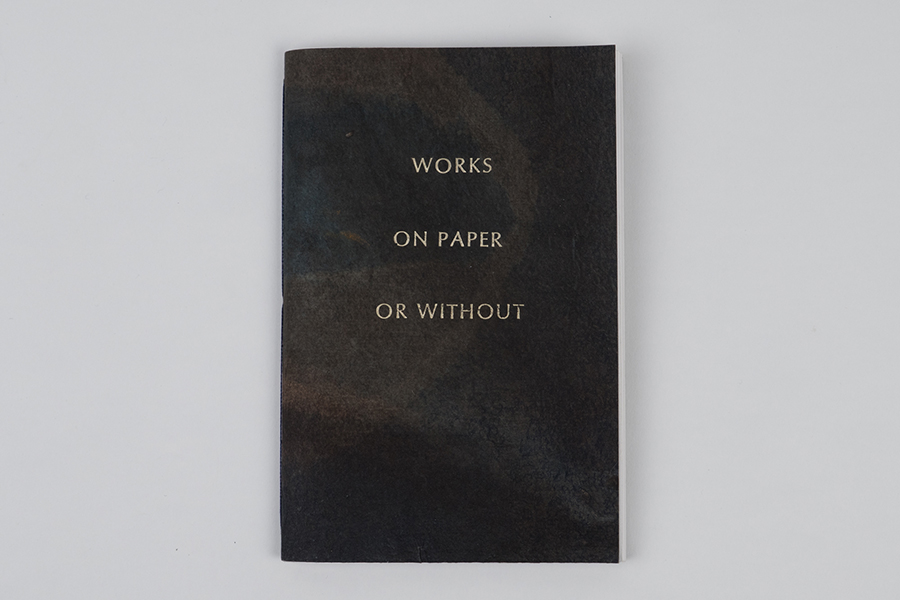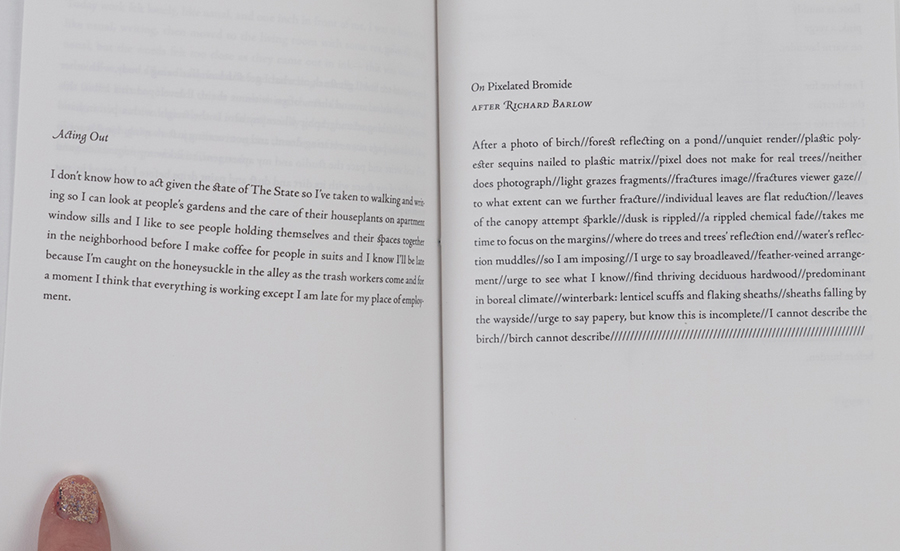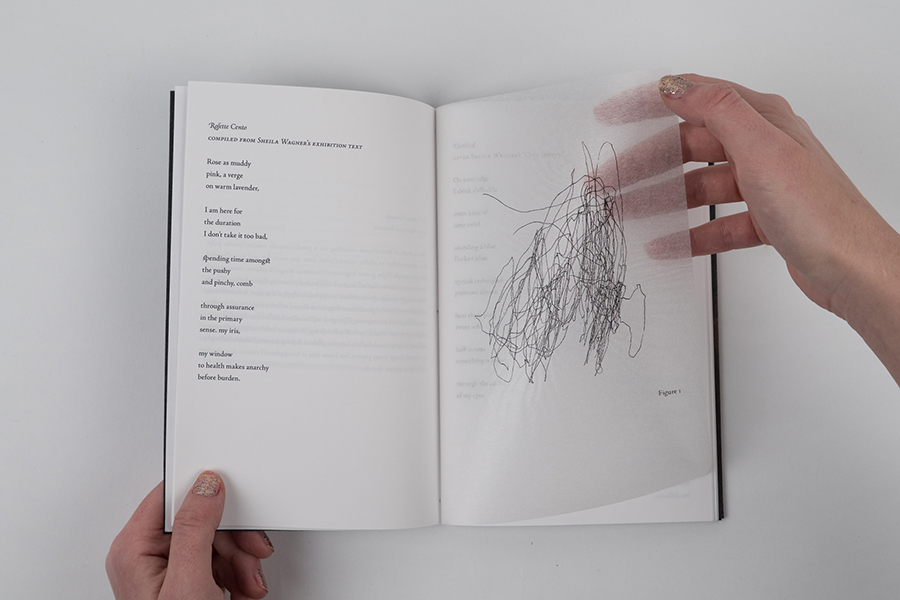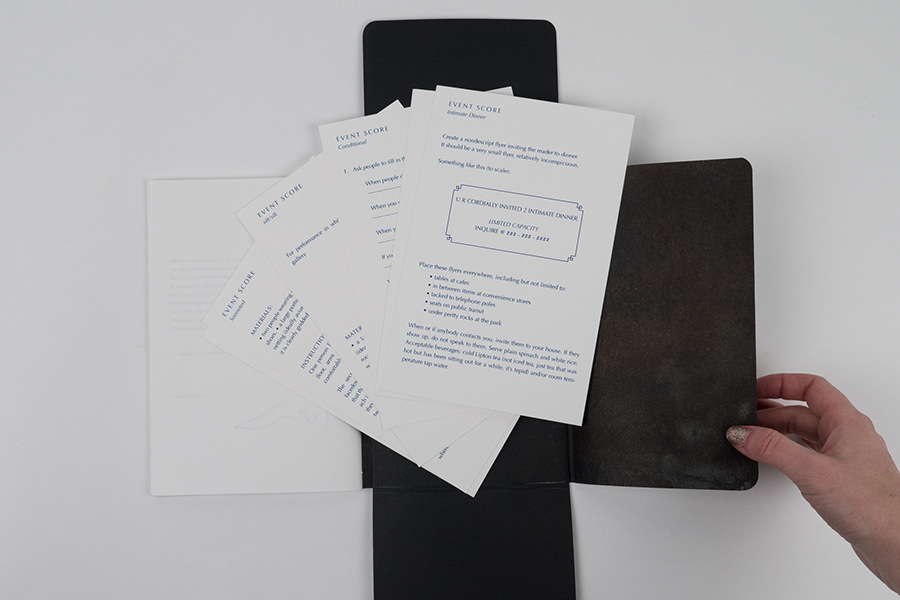
Miriam Karraker’s Dear Object
Published January 19th, 2018 by Juleana Enright
Local poet Miriam Karraker reflects on how her writing process relates and reacts to visual art.
Most often in natural progression, a body of work comes first, followed by critique. For poet/performance artist Miriam Karraker however, the two spark each other into existence and exist to probe deeper into each other’s psyche.
In her recently released, limited-edition chapbook, Works on Paper Or Without, Miriam has created a piece of art that dives into the history of the book as an art object. Written over the course of a summer’s residency at The White Page gallery, the book is a combined effort of friendship, resources, community, and critical theory. Teaming up with Alyson Coward of Qxiz Editions to design, print, and bind, Karraker’s chapbook isn’t simply a collection of poems but an ode to the intimate and complex ways we assign and inhabit language. Inside the hand-made flax paper pages resides an experience as tactile as it is visual, with precise attention to detail and secret passageways for the reader to be absorbed in. Through musings on the creative practice and an examination of text and poetry, Karraker’s work evokes critical theory while leaving room to partake in the mundane and find our presence in what Karraker calls “the precarious moment.”

Getting her start as a Religious Studies and French double-major at Lewis and Clark College, critical theory and the position of interrogating the self was always at the forefront of her studies.
“In undergrad, I was taking English classes and really disliked the scope of the department,” Karraker explains. “They really only offered a few post-colonial lit classes, cultural lit, women’s lit — I don’t even think they had queer lit — they were really tied to the canon. I don’t see the discipline interrogating itself very well in this context, at this college. I was also really interested in the ways that communities, in the institutional sense, self-define. I had this interest in cults and positioning of the self against a broader historical context, but really what it is is finding common threads.
“I was always taking poetry classes in college and wasn’t willing to give up a creative life outside of studying. I was always using poetry as a way to procrastinate my other work. Now I don’t see it as procrastination, I see it as a way to gain insight into future projects, even if I don’t know what it is yet.”
Now in the MFA program at the U of M, Karraker’s focus is studying poetry, although she says her interests have shifted into a metafictive or looser interpretation of what poetry is. After the election, Karraker began writing poems about chronic illness and the healthcare system but soon moved on to prose.
“I signed up for this long-form fiction class, kind of on a whim. I’ve had this idea for a novella for a really long time about a gallery guard at the Walker… This was a project on what writing is and what it means to write, but I realized that I haven’t really figured out what that means for myself yet. There’s not a lot of emphasis on critical theory in the MFA. I needed to make a scaffolding for myself.”
To create this scaffolding, Karraker proposed a residency at The White Page. She would be in the space all summer writing about the exhibits (Sheila Wagner’s Rosette and Derek Ernster’s man after my own boot, specifically) and hosting workshops offering fellow artists and writers a chance to expand their process outside of the ocular into the multisensory.
A big facet of the book are poems about Sheila and Derek’s work. Ekphrastic poems, meditations, musings, and perspectives.

“I mainly wrote about Rosette because it was thinking about how the ocular is estranged, how paintings are like bodies. We exist in these containers, and we think that there’s this stability. Her work encapsulates this trickery and slipperiness of image. I didn’t have the art words to describe it, but that’s kind of what the project for me was, translating what she was doing visually into another visual form, text. The text ends up being a sort of shadow of what was. A useful shadow for thinking about these bigger questions of how do we see ourselves in art. Art isn’t just artifice, it is an inhabitable thing. In poetry, a lot of things hinge on the visual. We talk about the image when we teach poetry. There’s this trend towards the visual, away from how poetry is a spoken art form and is intensely oral and acoustic. I structured a lot of the workshops around how to frame that in your own practice, thinking outside the visual.”

For the book launch, Karraker and Coward designed an archival installation. “We papered over the windows with sheets that have each page of the book printed, with cheap, yellow stock paper that conveys this to-be-determined, continuation. We staged a recreation of my studio space with my desk and the book. We have emails between me and Alyson, between me and The White Page, between Alyson and the paper people, between Alyson and Casey. We have Alyson’s typography research, all of my research, my teaching materials. We were inviting people to come touch this stuff. I got to look at Gertrude Stein’s archive last summer before I started working on this project, and I think it inadvertently rubbed off on the project. What would it mean if writers were more open about sharing their process?
“I think for a long time I was like ‘I can’t be a writer because writers are these mystic, god-figures who you don’t know how they do what they do but they do what they do really well.’ And I kind of hate that. Because we are just people. Your work is just a reflection of whatever weird experiences you’ve had so why not just be explicit about it. Process is also really intimate at the same time.”
In honoring that intimacy, only 35 copies of the chapbook were printed, a reflection of the number of people involved in making it.
“It’s a site-specific book in a lot of ways. My friends on the East Coast aren’t going to know about Sheila’s paintings but people here will. It needed to be released in a small way, in a small place. Because I’m just part of a bigger creative network of other people. This book is a group effort in that I needed other people to inspire work; I needed these conversations about how do you survive as an artist right now but also to make the physical object.
“It’s the fanciest chapbook I’ve ever seen, honestly. I never thought I would make something or be part of something this pretty. But it makes sense that it’s this pretty; it makes sense that it’s a dear object because every object is a group effort.”

Catch a live performance by both/and (aka Miriam Karraker) Saturday, January 20th, 6-11pm at Yeah Maybe, 2528 E 22nd St., Minneapolis. Featuring artists Jonathan Herrera, Sanford Mirling, Emmett Ramstad and Tamsie Ringler, and additional performances by mitchKaraoke, Sister Species, and Wild Firth.
Karraker has also recently released a series of poems in response to Jennifer Nevitt’s exhibit, Sans Terre, at Mia.
All photos by Jonathan Kaiser.
We can't do it without you.
Help keep independent arts journalism alive in the Twin Cities.